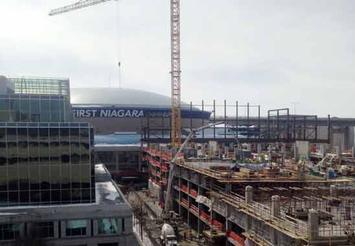
Prior to the holidays City Journal published my major essay on Buffalo in their fall issue. Here’s an excerpt:
Local planner Chuck Banas observes that while Buffalo’s regional population today is roughly the same as it was in 1950, the urbanized footprint of the region has tripled. “Same number of people, three times as much stuff to pay for” is the quip—and it’s true. Physical capital must either be maintained at great cost in perpetuity or ignored and allowed to become a drag on the city. Between 1980 and 2011, according to the University of Buffalo Regional Institute, Buffalo-area governments issued permits for almost 60,000 new single-family homes—while regional population declined. Given the gargantuan scale of state aid to the region, this is clearly not market-rate development.
While Buffalo’s urban advocates agree that investing in sprawl is misguided, they’re less critical about new construction in the urban center. The city’s $550 million light-rail line was an epic civic folly, yet Buffalo is currently reconstructing a downtown station on the line. More ill-conceived spending lies ahead. The region’s long-range transportation plan projects a need for an additional $100 million in capital expenditures through 2040, just to keep the existing line running—plus more operating subsidies every year. Seen in this light, neither cranes on the skyline nor bulldozers paving the countryside are necessarily good signs for Buffalo.
I learned a lot in Buffalo and it stimulated my thinking about post-industrial cities generally. What is the best way to bring some of these places back? What does it even mean for them to be back? If you wanted to inject a billion dollars of state or federal money into them, where would it most profitably be spent? These and other questions are ones I’ll be looking at in more detail during 2016.
Read the entire piece at City Journal.
Aaron M. Renn is a senior fellow at the Manhattan Institute and a Contributing Editor at City Journal. He writes at The Urbanophile, where this piece originally appeared.












